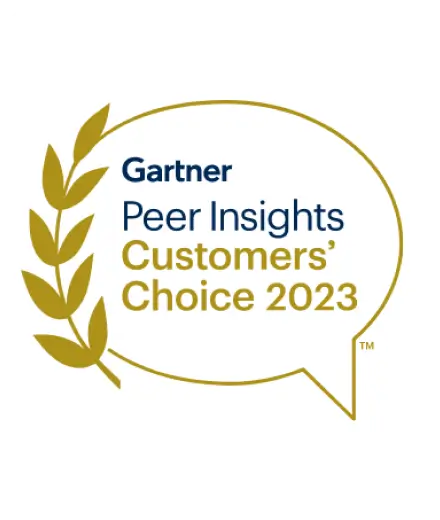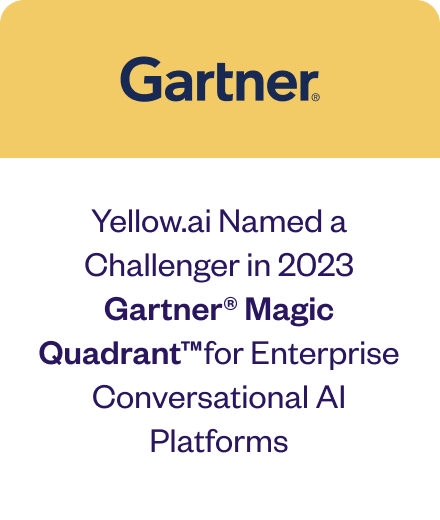Raghu Ravinutala, CEO and Co-Founder of Yellow.ai in conversation with Vartika Verma, Director Yellow.ai explains What is cognitive engagement cloud and the future of AI Automation.
Vartika: Welcome to Yellow.ai Lounge! Today we’re in talks with our CEO and Co-Founder, Raghu Ravinutala and we gonna dig deep into some of our clients, what makes us special, so here we go.
So Raghu, can you tell us a little bit about yourself?
Raghu: First, thanks a lot for inviting me to YM Lounge, Vartika! Myself, I’m the co-founder and CEO of Yellow.ai.
I have been working in the semiconductor and EDI industry for the last 20 years and that’s too old for startups in general. But, I think it gave a gave me a quite a bit of experience on how to develop and sell complex large scale enterprise software to companies and trying to use that knowledge while building the company.
Vartika: Is this your first start-up?
Raghu: Yes, It is.
Vartika: Awesome.. and when did you start this start-up and why?
Raghu: So, we started this in 2016, the start of 2016. The entrepreneur bug has been around for quite some time and I’ve been looking at multiple ideas, one thing that struck at that particular point of time was that from 2011 to 2015-16 there was a huge spurt of adoption for mobile messaging apps across the world. From 2011 to 2015-16, everybody was on WhatsApp talking with their friends. And everybody we were talking to in enterprises was, hey we’re using slack and It’s one of the new ways of communicating. it’s going to kill e-mail.
So, when we looked at that end also, Facebook bought WhatsApp for 16 billion dollars and it felt like if most of the users are going to be on WhatsApp, Slack, messaging apps, and voice. Then, enterprises need to market their products and services on these specific platforms. They need to sell their product and services on these platforms. They need to provide customer support, they need to provide employee support.
And from 1990 to 2015, billions and billions of dollars were spent on software to engage audiences on websites or mobile apps. We felt that a similar set of software has to be built for messaging apps, for enterprises to engage with them and do all the things I talked about.
We felt that’s a great opportunity and we got started.
Vartika: So, from 2016 to now, if you were to select five of your best or most challenging deployments, which ones would those be?
Raghu: The first ones that come to mind are what we did for Bajaj Finance. The reason it is special and challenging is for multiple reasons. That is the first deployment where we saw the power of what we were building.
So, the whole of 2016 and mid of 2017 was spent in POCs and figuring out whether it works or not for ourselves to see if we can commit over the long term, for this what we are building. So this was a case where Bajaj Finserv came and said that our number of users is growing dramatically and they need something in technology that can help them scale their user base while not scale their costs, processes, etc.
And, they started using our product to automate customer support and they expected about 25 to 50 thousand users per month in three months.
But, what really happened is the number of users grew beyond 10 lakhs within a span of four to five months which they were not expecting. Getting digital adoption for any digital product is very very tough, they need to spend a lot of money on mobile apps, etc. But this was naturally getting adopted.
And, that made Bajaj Finserv realize that hey if there is a natural adoption, it’s not just a tool, but it’s a channel for them not only to provide customer support but even acquire customers, provide products and services.
Since it was the first customer that scaled in volume at such a large scale of users, a lot of our products started breaking, a lot of issues, analytics. That pushed us to develop all these components much faster than anyone else in the market.
So, that’s why I believe, that’s the no.1 customer.
Vartika: So, you are talking about Bajaj Finserv and you know, what I hear from you that, messaging was really hot and the adoption was very easy because you know, the implementation was where the customers are.
So, what really did it solve for the brand and customers, if you were to look at it separately?
Raghu: Absolutely. So for the brand, of course, the first one was “Automation”. It automates about 99 percent of the queries that come through that particular channel. But, what more than that what company realized is that, the customer experience grew multiple notches up the NPS and CSAT for the end customers.
Because earlier the customers had to wait for an agent to be available. That agent to look out for applications to get the data required to answer and then answer back to the customer. Whereas now the bot goes to through the multiple systems automatically understands the user intent and provides the response.
What used to take 20 minutes to right now probably, 2 seconds. That’s the improvement in customer experience.
Vartika: Can we say that the three benefits are saving time, saving money, and adding efficiency to Bajaj Finserv?
Raghu: And I’ll add a fourth one, it’s also growing revenue.
What they say interesting is we never expected that to happen. They’re saying that if this channel is naturally getting adopted after providing customer support, why don’t we kind of, cross-sell and up-sell products that might be of value to that particular customer.
They’ve earlier tried that with humans selling, cross-selling, and up-selling from customer support, but the customers were not so tuned-in to listening to promotion from another person and being obligated to answer it back.
But when the same thing was been done by a digital assistant or a bot, they saw that, the customers were adopting that much faster and their number of leads almost increased by 4X.
And by Bajaj Finserv’s own admission, they’re right now doing more than 10 million dollars of incremental revenue, just through our Yellow.ai channel. I think, that’s been one of the biggest insights that we learned from this deployment.
Vartika: Right, so we hear all of these good things. Is there anything that was very distinct about Yellow.ai which lead us to, you know, this kind of growth and adoption at Bajaj Finserv?
Raghu: Yeah, absolutely. I think going back what I think differentiated us is taking the insights and converting that into product features. See, you can get all the insights into how people are using, and you can kind of let it be there, but if you kind of take from those observations to give an example:
“Hi, Vartika” versus “Hey, Vartika” could lead to completely different conversion rates. Conversion rates, just because users perceive it in two different ways. How do you analyze the data get back and use these insights to build back the product? I think that differentiated us in building in the product that provides more outcomes or better outcomes than any other product in the market currently.
Vartika: So, once a bot is built and it is out in the market with the brand, what is next for us at Yellow.ai? Do we stop working on it, do we continuously keep bettering the bot, can you talk a little bit about post-implementation what happens?
Raghu: That’s a very good question. That is where I think AI-based systems differ from regular software applications, where you deploy a software application and post that, you kind of forget except for periodic maintenance and stuff. But, AI applications are naturally, learning applications. That means, that either they need to have data to constantly improve the outcomes that they eventually provide and that data either could come from within the system or the data, could come from humans at the back end training back the system. Essentially, they need labeled data.
And at Yellow.ai, we provide both options. There are ways the system could learn. A typical example would be, do you mean this and based on user response to use that back for training or have the agents kind of, add the data to help the natural language understanding. So, Yellow.ai provides both the abilities.
Few customers train by themselves but Yellow.ai also offers a managed service, where the Yellow.ai personnel, can help keep the bot training updated on top of the self-learning that happens from the data accumulated from the user.
Vartika: So, Raghu are there any specific verticals or business functions that Yellow.ai specializes in?
Raghu: Yellow.ai is a horizontal platform. What we mean is that it provides wherever there is an interaction happening between two humans at this point in time, then there is a scope for one of them to be replaced by the digital assistant in helping automate those interactions.
And we’re constantly surprised by how enterprises are finding different ways to use this product. Initially we used to see a lot of customer support use cases and marketing use cases, which you would kind of feel that quite intuitive. Organizations have a lot of customer support and we can automate which we still see every company uses for that but there have been cases like Asian Paints, where they are using it to, automate orders from their dealers.
The use case here is that every month, at the end of the fortnight or at the end of the month we used to see a spurt of volume of dealers calling-in to place orders. Their call center is not elastic, so they cannot just increase the number of people, during the last two-three days of the month or the fortnight.
They were losing always those people were in the queue but not able to order and that was a problem. They used Yellow.ai’s cognitive cloud engagement platform to enable the entire ordering experience for their end dealers on WhatsApp in multiple languages. So, the dealers can now just place an order for Asian Paints orders on WhatsApp in Hindi, Marathi, and multiple languages.
Asian Paints are seeing an adoption with 30% of dealers using this interface every single month. Right, I’m seeing that adoption they extended the platform to so HR queries, their field agents, and their customers as well. So, that’s interesting.
Second use case or case study that I would like to talk about is one deployment that we’re are extremely proud of being an Indian company winning the contract for the world’s largest oil servicing company. They started using our cognitive cloud engagement platform for HR and IT automation.
We were just amazed that there are 13 different use cases that they are using for the product. Their drilling division uses the product to get details of their statement of work, and to standard operating procedures at the time of their duties.
There are different HR policies for several different countries so the bot automatically figures out which country folks from which country are interacting and automatically provides those policy details. It integrates with SAP’s ERP and provides SAP related information to their employees.
We continued to figure out that, customers are using it for multiple use cases and over a period of time. We believe that It could be a platform where the entire gamut of applications that you actually see on a mobile app ecosystem or a web application system, the spread of applications on conversational AI is as large or bigger than those use cases.
Vartika: So, Raghu, you spoke that, there are multiple business functions that you automate and I heard marketing, sales, HR, etc. So, can you tell us what you really do in marketing?
Raghu: The way that marketing has always worked is the products or services, are advertised and pitched to the customers. Assuming their specific need at each point of time, to give an example, if you take display advertising you get on to a website that’s probably pitching a financial product, it pitches a loan whereas, probably you have a lot of money in your bank and, essentially that is losing your eyeballs.
So, the only way that any marketing content can be personalized to your current context, is actually talking to you, because every other thing is actually a guest.
So it will be better saying what you’re looking for and based on that surface the content that’s relevant to you. So, essentially that is the ethos with which conversational AI power marketing works. That, any of the call to actions across a Google display advertising, Google search advertising, Facebook advertising, start with the conversation that could engage the user on a WhatsApp chatbot or conversational webpage and then, engage the user based on his current context requirement, needs, and moods. Then, driving towards the conversion, which is leading to a massive improvement in the number of conversions that they are achieving per the specific set of eyeballs they’re able to log on.
Vartika: Are there any implementations in this space?
Raghu: Yeah. I think Xiaomi is a great example. They launched their new phone recently and they kind of wanted to convey to a lot of people the features of that particular phone. Their traditional way of doing was through a microsite that explained features upon clicking the product. They replaced that microsite with a WhatsApp based microsite, the user clicks on a Facebook ad, they immediately land on a Xiaomi’s official WhatsApp account, with a bot driving the conversation. The bot interacts with the user, shows them the different features, and the videos.
Takes them through the conversation, and then the lead is automatically locked because the phone number is automatically authenticated by WhatsApp. Some beautiful things that we realized are that the traditional call to action in advertising is transitionary. You see on the website, you move off, even if you want to see the video, catchy video you can’t easily go back to them, you need to remember the website.
Here it is persistent. The Xiaomi’s official WhatsApp official account is on your contact list. It’s almost like your friend on the WhatsApp page, you can go back to the video, engage with it, know more details. So, it’s more persistent and continuous engagement for that brand, rather than a transitionary experience on a regular website, or a mobile app that it leads to. So, the brand is realizing much greater ROI for their ads and you know what, they came back for the second campaign already.
Vartika: That’s amazing! So, you say that you are like working on WhatsApp automation, is there any special tie-up with WhatsApp?
Raghu: Yes, we’re official WhatsApp’s business service provider. And, we work very closely with the WhatsApp team on their upcoming features, and how we’re thinking about kind of making the WhatsApp experience. Not just a supplement to the company’s communication channel, but, half the entire enterprise services being available on WhatsApp as a channel, right from doing banking transactions, getting insurance policies, getting customer support on WhatsApp itself. So, we believe that we’re one of those partners who are providing the deepest experiences on WhatsApp, by closely working with their team.
Vartika: What do you think has been driving force, behind this growth?
Raghu: For any software enterprise companies, the company needs to master two basic skills. One is the ability to build software that is useful and valuable. Second, the ability to sell that software to a lot of enterprises, so they can derive value out of that software. The rest all is whether it’s a conversational AI or whether it’s something else, is built on top of this basic framework. So, something that helped us build this is kind of look at the organization as is to different pieces and build a culture that is resonating with each of these two different pieces of the company.
So, let’s take the product first, right. I think the overall type of people we hire in the entire product organization, the basic thing that we looked at was, their hunger to deliver value through software. So, people who are proud of what they built and, they get proud when they see that, they used for someone else and they’re realizing tremendous value out of it.
That’s I think the basic tenet we look for in the people and the reason we grew because we hired lots of people who have that passion towards creating software that delivers the value.
The second thing that really sets this team apart is “Being creative at the cost of making mistakes“.
So, I think the culture always allowed for a lot of people, to try out multiple things right from someone who has joined just out of college, to someone who has 10 years of experience. Everybody has the freedom to try out new features, a new way of doing things. And, assuming that they fail and there is an ability for us to recover and build those things out. I think, that’s what differentiated this organization.
Whereas there is a complete set of culture, that we built in the sales team where we want that hunger for, delivering value or hunger for success. The sales team really thrives on ambitious targets and ambitious targets result in ambitious people who always think that one of the things that I’m really proud of is whenever we have a conversation around quota and target sales that you typically have with salespersons, they are not satisfied with that quota. They come back and say, “Hey, this is not what it is.. we probably need to do 20% more than this!”.
That’s the kind of organization where our sales and marketing team are really driving and, that’s what differentiates us in terms of culture across these two teams.
Vartika: So, talking of teams. Are your teams based out of India alone?
Raghu: No, teams are spread across right now, 5 countries at least. One belief we always had while building the enterprise software is, we’re providing software that is part of the core experience for the enterprise. So this is one that’s enabling them to talk to their customers and when we’re providing something of that core value.
We need to work very closely with enterprises, to determine how they want to engage with the audience, how they want to customize, how they want to really get value out of the software. And, very important is to have that presence in their premises. Meeting them quite often, get imbibe their philosophy of engagement and built into the product, So the customer-facing teams are spread across the places where our customers are existing. And we continue to do that, whereas, the core R&D and core operations are fit-outs of Bangalore.
Vartika: So Raghu, considering this such a new segment in itself, AI is at a very nascent stage. You know even the team members who you’ve hired, must not be having too much experience in this space. So, what do you think with your experience, are the top three challenges which if a new joinee faces. You know you want to say “It’s alright, you’ll get there”
Raghu: Yes, so, one thing that I really want to say is, the journey’s really going to be very messy, where the journey is going to be faced with a lot of obstacles. Because we’re doing something that we just cannot copy that some company has done this thing earlier and succeeded. Hey, we need to kind of use those models to do that. I don’t think there is any company like that, that exists the way we can copy. So, most of the things that we’re doing for the first time across the world. Customer expectations are very high. So, we’ll go through a lot of problems. Lots of messiness in the software, because we’re trying, experimenting and improving.
So, one thing that I would expect everyone to have the resilience and perseverance, but at the same time, we compensate for the pain that we go through because of this process by the pride that you imbibe in doing something that it’s pioneering across the world. And I think, that’s the mindset that we really want everyone to carry during the company, feel free to fail but obviously have guardrails around how we can come back with those situations and stuff and, always be mindful of the fact that the entire leadership is behind you, even if you fail. And, kind of that should give you the ammunition to go against.
Vartika: So Raghu, when you started out this company, what did you have on your mind and what did you want to achieve? And, you know, so much has changed since then, so, how do you keep changing the pace of your company and vision?
Raghu: When we started, I think it was a basic insight that Hey, messaging that people were gonna use it. If you do something in that space, it’s going to be massive and, we’re going to make a lot of money, I think, that was a thought process by which we started. But as we started to evolve, people joining in and a lot of inspiration at the kind of people we had in the company as well.
And, now it is kind of evolved into a much larger piece of what we think we can do. The quote in it lies saying that, “If the world is moving in more towards conversation, more cognitive, where the systems understand what’s being communicated through them.“
We believe that the entire CRM is under a rapid disruption. What is CRM? CRM essentially is a system that is enabling customers to manage their relationships with enterprises or enterprises to manage their relationships with customers. The way that CRM has been looked upon is a system of record, in the sense that Hey, I’m storing all my customer information and will be used by some humans to take that information and to manage the relationship with the customer.
We think that the future of CRM will be not just a system of engagement but, will be a system of automation. In the sense that, I’m not just storing details for humans to come, take information, and drive engagement with customers. As a system, I’m driving the entire engagement with the customers by taking in all the data and instructions from the human.
I think that’s going to be the transformation of how a customer relationship management is going to happen in the future. The rest of the backend is just a database, right, we’re just storing the information. It’s the automation that is driving the relation with the customer. So, we believe that Conversational AI is the new CRM in the cognitive era and we want to be the company that is driving the customer relationship for pretty much all the enterprises in the world and be a leader in the segment.
This interview can also be watched on Yellow.ai Youtube Channel.





















